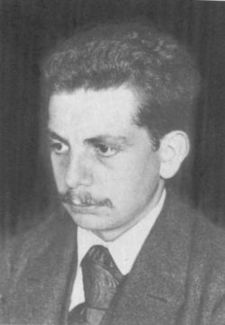Karl Koenig 1902 - 1966
December 23, 2008
 Karl
Koenig (Konig) 1902 -
1966 was an Austrian Jewish Paediatrician who fled Nazi Germany to find
refuge in Scotland where he founded in the Camphill
Movement, an international movement of
therapeutic intentional communities for those with special needs or
disabilities.
Karl
Koenig (Konig) 1902 -
1966 was an Austrian Jewish Paediatrician who fled Nazi Germany to find
refuge in Scotland where he founded in the Camphill
Movement, an international movement of
therapeutic intentional communities for those with special needs or
disabilities.
Camphill Communities offer homeopathic and anthroposophical medicine.
Karl Koenig conducted research into homeopathy. Koenig emphasized the study of the Doctrine of Signatures as a means to gain insight into materia medica.
Karl Koenig was a friend of Llewelyn Ralph Twentyman, Edward Christopher Whitmont.
1927 Karl Koenig used microdilutes to experiment on frogs and fungi. He discovered that by using dilutions of of lead and silver nitrate ranging from 1 to 15c he could cause a premature metamorphosis in Rana fusca (common frog tadpoles) or kill them or the fungus in the water.
Once again here we see that homeopathic drugs can have negative organic affects. Controls were used and the sinusoidal curve that we see in many experiments of diverse measures is first noted here. On the Effect of Extremely Diluted (”Homeopathic”) Metal Salt Solutions on the Development and Growth of Tadpoles. Zeitschrift fur die Gesamte Experimentalle Medizin, 34, pp. 279-306.
1929 Vladimir Vondracek repeated Koenig’s work, and instead of lead and silver nitrate used gold chloride and a different species of frog. At 12c he also reported a significant increase in the mortality of tadpoles, and also obtained a repetition of the sinusoidal curve. The Mortality of Tadpoles in Ultra Solutions Zeitschrift fur die Gesamte Experimentelle Medizin. 66 pp. 533-538
Karl Koenig studied zoology, biology and medicine in Vienna. During this time he struggled with questions regarding the evolution of life. It was the encounter with Johann Wolfgang von Goethe’s work on natural science, Johann Wolfgang von Goethe’s approach and methods, that gave him the direction for finding answers.
Soon he got to know followers of Rudolf Steiner, and during the first encounter with Ita Wegman she asked him to work as an assistant at the Klinisch-therapeutische Institut in Arlesheim in Switzerland. The co-founder of the institute was Rudolf Steiner.
It was also in Arlesheim where he started to give numerous lectures and courses, rich in content and covering a great variety of topics. As we can read in his ‘Autobiographic Fragment’ the roots of his deep inner connection and relationship to children with special needs are to be found here in Arlesheim.
A lecturing journey to Silesia lead to the marriage with Tilla (Maasberg) and his deep connection with the social and religious impulses of the Herrnhut brotherhood where she originated.
Because of his Jewish descent he had to give up his work as general practitioner and in the institute of Pilgramshain, which he had just founded with Albrecht Strohschein and which was one of the first curative educational centers based on Anthroposophy. Also the School for Social Work, founded with Emil Bock and himself in Eisenach in 1932, could not be continiued.
In 1936 he fled via Prague back to Vienna where he restarted his surgery. Already in 1938 he was as succsessful with his work as in Silesia. During this period he lead an anthroposophical study group with young people, many of them jewish.
Together with this group he soon had to flee again. They reached Scotland by different ways. The old “Camphill” estate, a former hiding place of the last knights of the “Order of the Temple” became the place of origin for a community based on curative education, which then developed during the postwar years as the Camphill Movement and soon was called for in many countries of the world.
For Karl Koenig the foundation of such a community was an attempt to realize suggestions Rudolf Steiner had made for for social life based on insight into spiritual reality. For him it was an endeavour to take up anew the true and deeper tasks that had been hindered by the destruction of Central Europe.
Karl Koenig wrote Samuel Hahnemann, Brothers and Sisters: A Study in Child Psychology, On Reading and Writing.
Of interest:
Maximilliam Joseph Koenig 1829 - immigrated from Prussia to America in 1949 and became a homeopath under Carl Gottlob Caspari. Maximilliam Joseph Koenig then trained John Michael Weick.** **